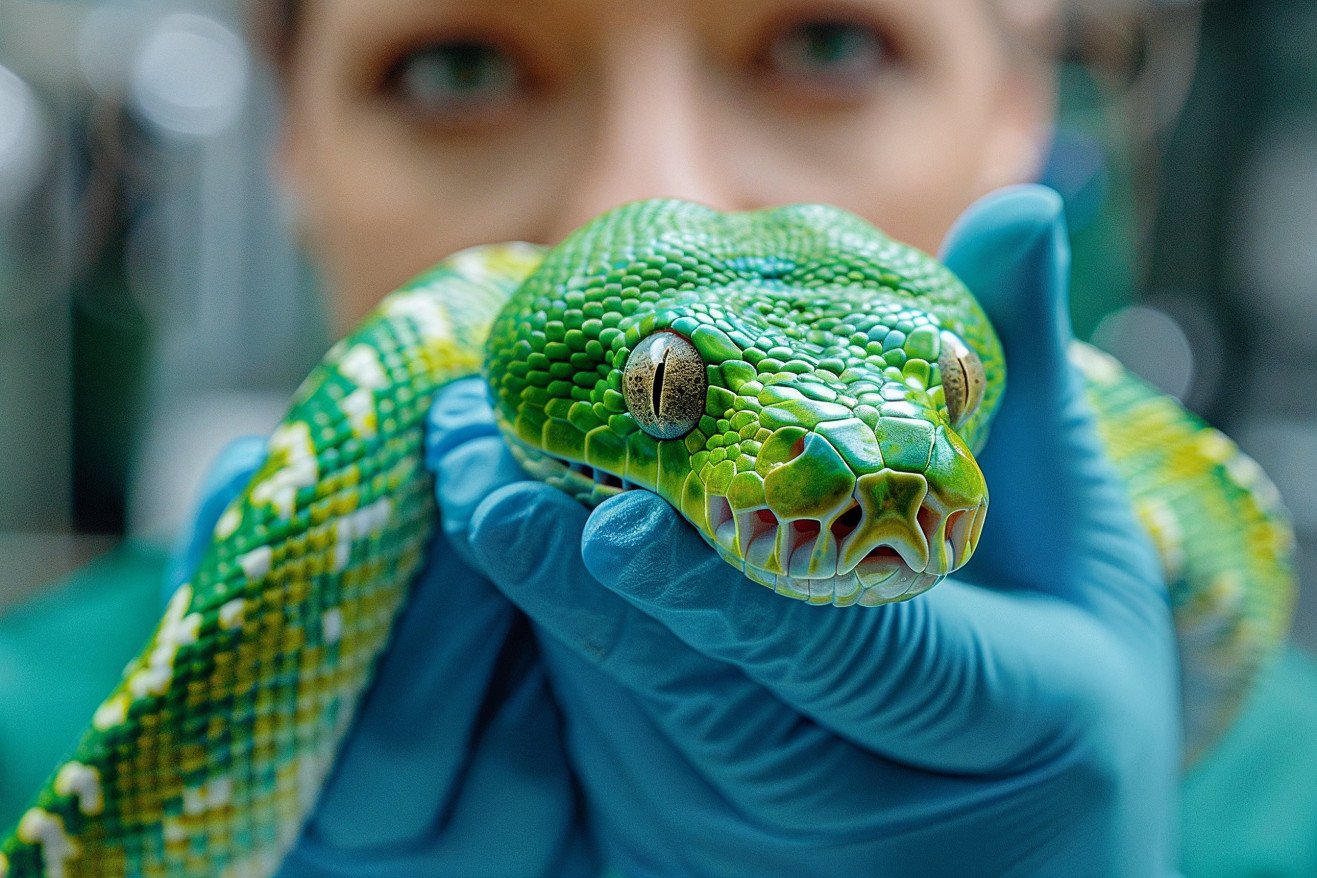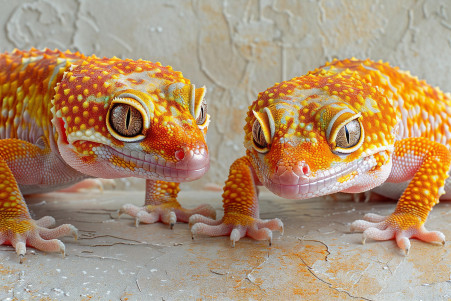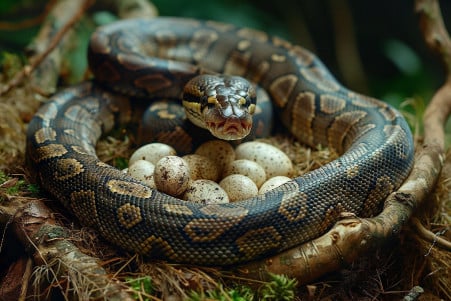Snake Sexing: Identifying Male vs. Female
29 March 2024 • Updated 29 March 2024

Knowing a snake's sex is important for proper care and breeding, but how can you tell if your snake is male or female when they don't have external genitalia? Probing is the most accurate way to sex a snake. Gentlypress along the tail base near the vent to extend the males' reproductive organs - hemipenes will protrude if male. Females lack hemipenes but may have a small bulge from eggs or eggs remnants. Probing is best done by an expert to avoid injury.
If you don't have experience with snakes, you may not know how to sex a snake. This can make it difficult to determine if you have two snakes of the opposite sex or the same sex. In this article, we'll cover the anatomical differences between male and female snakes and the methods used by herpetologists and experienced reptile handlers to determine a snake's sex. From vent probing to observational cues, you'll learn how to sex a snake safely and accurately.
How can you tell if a snake is male or female?
Visual Cues: Looking for Differences
While probing and other hands-on techniques are most definitive, experienced reptile keepers can often determine a snake's sex through careful observation of its physical characteristics. According to the Merck Veterinary Manual, it can be difficult to visually tell males and females apart in some reptiles, although some species have differences in size, color, or scale patterns.
One of the most reliable ways to tell snakes apart visually is by the shape and length of their tails. As GarterSnake.info notes about garter snakes, males have longer, thicker tails that taper gradually, while females have shorter, thinner tails that taper more abruptly. This difference becomes more pronounced as the snakes mature.
Body size can also be a clue to a snake's sex in some species. In general, females are larger than males because they need more space to carry eggs or young. However, in king cobras, Pets on Mom.com says that males can grow to more than 18 feet long and weigh more than 40 pounds, while females are much smaller.
Other potential visual clues to a snake's sex include the shape of the head, the presence of cloacal spurs near the vent, and differences in behavior, such as males being more likely to pursue females. However, these differences may be subtle and vary from species to species. In some cases, it may be difficult to determine a snake's sex visually, especially if it's a juvenile or a species that doesn't have many differences between the sexes. In these cases, probing or another method may be necessary. However, experienced snake handlers may be able to determine a snake's sex visually by looking for a combination of physical characteristics.
Probing and Popping: Advanced Methods
While it is possible to determine a snake's sex with greater accuracy using hands-on methods like probing and popping, these methods are more advanced and can only be performed by trained professionals. As explained by Vida Preciosa International, Inc., the "cloacal probing technique" involves carefully inserting a smooth, lubricated probe into the snake's cloaca to check for the presence of hemipenes, the male snake's sex organs. It is important to choose the right size probe because if the probe is too small, it can go into the female's hemipenial homologs, which can lead to an incorrect determination.
The "popping" method is often used to determine the sex of hatchling snakes, according to the Aussie Pythons & Snakes Forum. This method involves applying pressure near the base of the tail to cause the male's hemipenes to evert. However, the Field Herp Forum warns that popping is very invasive and should only be done by experienced handlers because if it is done incorrectly, it can cause injury or prolapse.
As the experts point out, both probing and popping are most accurate when performed on snakes that are sexually mature and the appropriate size. Performing these methods on snakes that are very small or young increases the risk of injury. While these methods can provide the most accurate determination of a snake's sex, they should only be performed by experienced reptile professionals.
Non-Invasive Sexing Methods: Molecular and Imaging Approaches
Sexing snakes can be done without the use of invasive methods such as probing or popping. According to a study in PMC, molecular sexing methods using genetic markers can offer a straightforward and reliable way to determine a snake's sex. This method requires the use of DNA extracted from non-invasive samples like shed skin or blood.
The researchers created three candidate PCR sexing markers that can amplify fragments from the Z and W sex chromosomes, which results in a size difference between male (ZZ) and female (ZW) snakes. Another study confirmed the accuracy of this multiplex PCR assay, demonstrating that it can be used for wildlife forensics and in the commercial snake trade.
In addition to molecular methods, imaging methods like ultrasound and radiography can be used to view a snake's internal reproductive organs without having to touch the animal, according to Unusual Pet Vets. Ultrasound, in particular, is a non-invasive way to determine sex and evaluate the reproductive health of a snake.
These more advanced non-invasive methods of sexing snakes have several benefits. They are less stressful and risky for the snake than physical probing or popping. However, they may require access to equipment and expertise that's not always available to reptile owners and breeders.
Sexing Snakes at Different Ages
Sexing snakes can be especially difficult at different ages, as the African Snakebite Institute points out. For some species, physical differences like tail length and girth may not be noticeable until the snake has reached sexual maturity. The CornSnakes.com Forums note that the "candling" method, which involves shining a light through the tail to look for hemipenes, can be used to sex baby snakes, but it's most effective when used with lighter-colored morphs.
While it may be tempting to try more invasive methods like probing or popping on very young or small snakes, the Field Herp Forum stresses that doing so increases the likelihood of harming the snake. Instead, experts suggest waiting until the snake has reached an appropriate size and age before using these hands-on methods. As the Aussie Pythons & Snakes Forum notes, this often happens around the time the snake starts eating regularly as a juvenile.
No matter the age of the snake, it's important to be patient when sexing it. Waiting for the snake to mature can help ensure that both visual and physical methods of sexing are more reliable and accurate. Meanwhile, seeking out the help of experienced reptile handlers or veterinarians can help guarantee that the snake is sexed in the safest and most ethical way at any age.
Accuracy and Reliability: How to Judge Sexing Techniques
Sexing snakes is not an exact science, and the accuracy and reliability of the various sexing techniques can vary widely. According to the Aussie Pythons & Snakes Forum, probing can be a reliable method if performed correctly, but the results should be considered a guide and not taken as gospel. If done incorrectly, probing can cause injury to the snake and inaccurate results.
For some species, visual identification of physical characteristics such as tail length and body size can be effective, as mentioned by GarterSnake.info and Pets on Mom.com. However, these characteristics can be hard to discern and unreliable, especially in juveniles and certain species.
More advanced methods such as genetic testing and imaging techniques are more accurate, as outlined by Wellspring Herpetology Culture. However, these methods often require special equipment and expertise that may not be available to all reptile owners and breeders.
In the end, the experts at VenomousReptiles.org suggest using a combination of sexing techniques and getting confirmation from experienced handlers to ensure the most reliable and definitive results. By knowing the strengths and weaknesses of each method, reptile lovers can ensure they're making informed decisions that accurately determine their snake's sex while keeping the animal's safety in mind.
Conclusion: Ethical and Safe Methods of Snake Sexing
While sexing snakes is important for many reasons, including proper care, breeding, and understanding behavior, it's important to do so in a way that is ethical and safe. The methods described by the experts in this article, from visual sexing to invasive probing, all have their own benefits and drawbacks.
Regardless of the method used, the most important thing is to put the snake's welfare first. Mishandling or inexperienced attempts at sexing can lead to injury or undue stress for the animal. As a result, we strongly recommend that if you are unsure about your ability to accurately sex a snake, you seek help from an experienced reptile handler or veterinary professional.
By prioritizing the snake's welfare and using caution, you can accurately determine your snake's gender and gain valuable insights into its biology and care needs. However, it's important to remember that the snake's health and safety should always come first. With the right knowledge and precautions, you can determine your snake's gender while promoting its long-term welfare.


